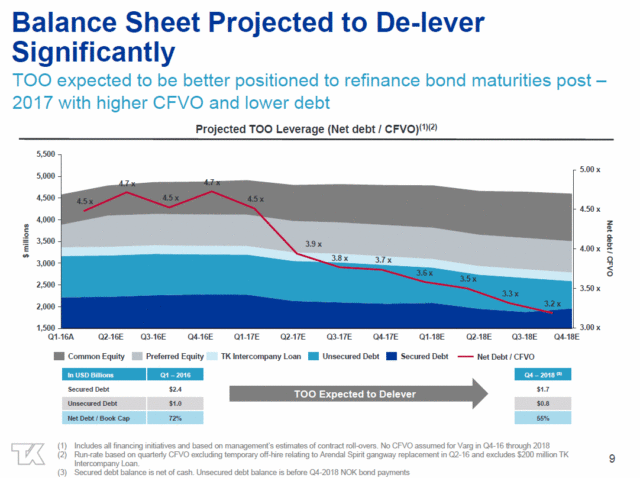Reviewing Teekay Offshore’s financial results (NYSE: TOO), it strikes me as rather obvious that they have missed their initial early 2016 targets when they proposed a partial equitization (issuing common units, preferred units, and some refinancing) of their debt problems. They also borrowed $200 million from the Teekay parent entity (NYSE: TK).
In Q1-2016, they delivered a presentation with this chart:
In subsequent quarters, the company has generally not referred to progressing tracking to this projection, mainly because their debt to cash flow through vessel operations ratio has not met these targets. While the underlying entity is still making money, revenues are eroding through the expiration and renegotiation of various contracts, couple with some operational hiccups (Brazil) that is not helping matters any.
Putting a lot of the analysis away from this article, while in 2017 the future capital expenditure profile is going to be reduced (which would greatly assist with the distributable cash flows), the company doesn’t have a lot of leftover room for matters such as debt repayment and working on improving their leverage ratios in relation to cash generation ability. This leaves them with the option of continuing to dilute or depend on the parent entity for bridge financing. Indeed, one reason why I believe management thinks the company is still open for dilution is due to them employing a continuous equity offering program – they sold nearly 1.9 million units in the quarter at an average of US$5.17/unit. If they don’t think the company is worth US$5.17/unit, why should one pay more than that?
I don’t believe that they are a CCAA-equivalent risk in the current credit market (this is a key condition: “current” credit market), and I also believe that their preferred units will continue to pay distributions for the indefinite future, I don’t believe their common units will be outperforming absent a significant and sustained run-up in the oil commodity price. Note that there is a US$275 million issue of unsecured debt outstanding, maturing on July 30, 2019, which will present an interesting refinancing challenge. Right now those bonds are trading at around a 10% yield to maturity.
I have no positions in TOO (equity or debt), but do hold a position in the Teekay Parent’s debt (thesis here).

Nice blog! Have you ever considered publishing on Seeking Alpha where you can get paid by the click? I came across your blog when google searching for analyis if TK’s latest earnings since I’m also long the 2020 bonds. Interesting that TK equity had a more negative reaction to TOO’s earnings than TOO equity.
I then found the rest of your blog a good read as well. If you were on Seeking Alpha, your posts would just show up in my feed and you’d also get paid!
I’d much rather keep exclusive access to my articles on my low traffic website, but thank you for the suggestion.
As for TK complex, it really makes zero sense at all for them to be paying dividends/distributions in their current state if their actual goal is to deleverage. They basically should have bit the bullet back in late 2015 and just scrapped it then and told investors if they wanted distributions to just invest in the preferred units. That said, TK’s fortunes are basically riding on TGP, while if they can clot the bleeding on TOO/TNK that’s just gravy at this stage.
An interesting factoid is that the NOK bonds (that were maturity-extended) have a covenant that any dividends paid must come out of equity proceedings. You can be sure management will be hitting that continuous offering again and again…
I think the biggest reason divs were not totally eliminated was that TK is 40% family owned and the family needs some cash flow for living expenses. Otherwise, you’re right that a token div doesn’t make much sense. Most logical is complete elimination, speeding up delevering, and then after that’s done, but while the share price is still crashed, buyback stock.
Great factoid on the NOK bonds. Makes me feel even better about my 2020 TK bonds. I also have the TGP-A preferreds which have higher interest rate risk and are lower in the cap structure but lower credit risk than TK and the preferreds yield an extra 50 bps. Overall, I see them as equally attractive when they’re both trading at par.
Resolute Investments also bought into TK’s secondary offering some months ago. One would think they would be playing the long game, but they obviously have a tremendous incentive to not seeing TK go through CCAA-equivalent.
The TOO preferreds also look somewhat interesting, but there is so much outstanding now that I question whether the seniority is worth anything in relation to just purchasing the June 2019 debt. Once they are done with the capital commitments they can start paying back the NOK debt at the end of 2018 but then they’ll run into the issue of asset deployment. Not pleasant for them or most of the other players. The risk on the common distributions on this point is skewed on the downside rather than upside, and one can make a low probability argument that they can just shut off the preferred distributions as well (although if they did that I’d probably buy some on the subsequent crash).
[…] quarter I wrote about how Teekay Offshore units are “not going anywhere“, and that was an understatement considering this stock graph in the […]